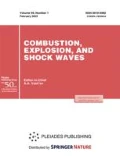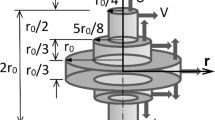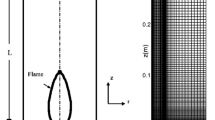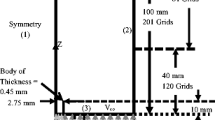Abstract
Transient dynamics of formation and extinction of methane- and ethylene-fueled flames above the flat porous burner in an oxidizing atmosphere is numerically investigated. The simulated scenarios replicate the experimental conditions of the BRE (Flamenco) project of the ACME program focusing on combustion research in microgravity. The 3D unsteady model includes the multi-step and multi-component chemical mechanisms of fuel oxidation, formation and oxidation of soot, and the radiative transfer. The model is validated for the methane-fueled jet laminar diffusion flame in normal gravity and for the ethylene flame developing in short-duration free-fall microgravity in the drop tower. The microgravity flames are then simulated at longer times, and the range of fuel mass fluxes characteristic of solid and liquid combustibles is explored. In all the cases considered, combustion is essentially unsteady, in spite of the constant fuel supply rate. During the initial stage of flame growth, the temperature in the reaction zone persistently decreases due to the radiative losses down to the level causing local extinction, oscillations, and complete extinguishment of the flame. The effect of fuel type and mass flux at the burner surface on the flame lifetime and on its disintegration dynamics is demonstrated. The sensitivity of the results to the chemical mechanism used in the simulations is examined. The radiative fraction in the microgravity flames is found to be by an order of magnitude higher than that in the normal gravity flames produced by the same burner. The radiative losses are shown to be the reason for extinction and instability in the microgravity flames considered in this work.
















Similar content being viewed by others
REFERENCES
D. L. Dietrich, H. D. Ross, D. T. Frate, J. S. T’ien, and Y. Shu, “Candle Flames in Microgravity," in The 3rd Int. Microgravity Combustion Workshop, NASA Lewis Research Center, US, Cleveland, Ohio, April 11–13, 1995, pp. 31–36; https://ntrs.nasa.gov/search.jsp R=19960008386.
Y. Zhang, M. Kim, H. Guo, P. B. Sunderland, J. G. Quintiere, J. de Ris, and D. P. Stocker, “Emulation of Condensed Fuel Flames with Gases in Microgravity," Combust. Flame 162 (10), 449–3455 (2015); https://doi.org/10.1016/j.combustflame.2015.05.005.
Y. Zhang, M. Kim, P. B. Sunderland, J. G. Quintiere, and J. de Ris, “A Burner to Emulate Condensed Phase Fuels," Exp. Therm. Fluid Sci. 73, 87–93 (2016); https://doi.org/10.1016/j.expthermflusci.2015.09.025.
A. Markan, P. B. Sunderland, J. G. Quintiere, J. L. de Ris, and H. R. Baum, “Measuring Heat Flux to a Porous Burner in Microgravity, Proc. Combust. Inst. 37 (3), 1–8 (2019); https://doi.org/ 10.1016/j.proci.2018.05.006.
A. Markan, P. B. Sunderland, J. G. Quintiere, J. L. de Ris, D. P. Stocker, and H. R. Baum, “A Burning Rate Emulator (BRE) for Study of Condensed Fuel Burning in Microgravity," Combust. Flame192, 272–282 (2018).
Advanced Combustion via Microgravity Experiments (ACME); http://spaceflightsystems.grc.nasa. gov/acme/.
Space Experiment “Flamenco" (TsNIIMash, Roscosmos State Corporation, 2019); http://tsniimash.ru/ science/ scientific-experiments-onboard-the-is-rs/cnts/experiments/flamenko/?sphrase_id=3100.
ANSYS Fluent Theory Guide (ANSYS, Inc., 2017).
K. C. Smyth, Diffusion Flame Measurements(Building and Fire Research Laboratory, NIST); https:// www.nist.gov/el/fire-research-division-73300/diffusion-flame-measurements.
U. Bonne, “Radiative Extinguishment of Diffusion Flames at Zero Gravity," Combust. Flame 16 (2), 147–159 (1971); https://doi.org/10.1016/S0010-2180(71)80080-9.
S. H. Sohrab, A. Liñan Martı́nez, and F. A. Williams, “Asymptotic Theory of Diffusion-Flame Extinction with Radiant Loss from the Flame Zone," Combust. Sci. Technol. 27 (3), 143–154 (1982); https://doi.org/10.1080/00102208208946983.
A. Yu. Snegirev, “Perfectly Stirred Reactor Model to Evaluate Extinction of Diffusion Flame," Combust. Flame 162(10), 3622–3631 (2015); https://doi.org/10.1016/j.combustflame.2015.06.019.
A. Kazakov, J. Conley, and F. L. Dryer, “Detailed Modeling of an Isolated, Ethanol Droplet Combustion under Microgravity Conditions," Combust. Flame 134 (4), 301–314 (2003); https://doi.org/10.1016/S0010-2180(03)00091-9.
G. Paczko, N. Peters, K. Seshadri, and F. A. Williams, “The Role of Cool-Flame Chemistry in Quasi-Steady Combustion and Extinction of \(n\)-Heptane Droplets," Combust. Theory Modell. 18 (4/5), 515–531 (2014); https://doi.org/10.1080/13647830.2014.934296.
B. H. Chao, C. K. Law, and J. S. T’ien, “Structure and Extinction of Diffusion Flames with Flame Radiation," Symp. (Int.) Combust.23 (1), 523–531 (1991); https://doi.org/ 10.1016/S0082-0784(06)80299-7.
S. Berhan, A. Atreya, D. Everest, and K. R. Sacksteder, “Radiant Extinction of Gaseous Diffusion Flames," in 5th Int. Microgravity Combustion Workshop (NASA/CP-1999-208917), NASA Glenn Research Center, US, Cleveland, Ohio, May 18–20, 1999, pp. 43–46; https://ntrs.nasa.gov/ archive/nasa/casi.ntrs.nasa.gov/19990053965.pdf.
K. J. Santa, B. H. Chao, P. B. Sunderland, D. L. Urban, D. P. Stocker, and R. L. Axelbaum, “Radiative Extinction of Gaseous Spherical Diffusion Flames in Microgravity," Combust. Flame151 (4), 665–675 (2007); https://doi.org/10.1016/j.combustflame.2007.08.009.
E. Kuznetsov, A. Snegirev, and E. Markus, “Radiative Extinction of a Diffusion Flame in Microgravity," in Proc. of the 9th Int. Seminar on Fire and Explosion Hazards, St Petersburg, Russia, April 21–26, 2019 (Peter the Great St. Petersburg Polytech. Univ., 2019), Vol. 1, pp. 214–224; http: //doi.org/ 10.18720/spbpu/2/k19-73.
A. Kazakov and M. Frenklach, “Reduced Reaction Sets Based on GRI-Mech 1.2," http:// combustion.berkeley.edu/drm/.
T. Lu, “Reduced Mechanisms Download. A 22-species Reduced Mechanism and a 32-species Skeletal Mechanism and for Ethylene–Air Based on USC-Mech II; http://spark.engr.uconn.edu/ mechs/mechs.htm.
Z. Luo et al., “Chemical Explosive Mode Analysis for a Turbulent Lifted Ethylene Jet Flame in Highly-Heated Coflow," Combust. Flame 159 (1), 265–274 (2012).
E. Kuznetsov, E. Markus, and A. Snegirev, “Dynamic Determination of the Mean Radiation Path Length in the Simulations of Transient Flame Development," in 15th Int. Conf. and Exhibition on Fire Science and Engineering, Interflam 2019 Posters, Royal Holloway College, UK, July 1–3, 2019; https: //www.intersciencecomms.co.uk/html/conferences/ Interflam/if19/Programmeif19.htm.
S. J. Brookes and J. B. Moss, “Prediction of Soot and Thermal Radiation in Confined Turbulent Jet Diffusion Flames," Combust. Flame 116 (4), 486–503 (1999); https://doi.org/10.1016/S0010-2180(98)00056-X.
A. Snegirev, E. Markus, E. Kuznetsov, J. Harris, and T. Wu, “On Soot and Radiation Modeling in Buoyant Turbulent Diffusion Flames," Heat Mass Transfer 54 (8), 2275–2293 (2018); https://doi.org/10.1007/s00231-017-2198-x.
C. P. Fenimore and G. W. Jones, “Oxidation of Soot by Hydroxyl Radicals," J. Phys. Chem. 71 (3), 593–597 (1967); https://doi.org/10.1021/j100862a021.
R. Puri, R. J. Santoro, and K. C. Smyth, “The Oxidation of Soot and Carbon Monoxide in Hydrocarbon Diffusion Flames," Combust. Flame97 (2), 125–144 (1994); https://doi.org/10.1016/0010-2180(94)90001-9.
K. McGrattan, S. Hostikka, R. McDermott, J. Floyd, and M. Vanella, “Fire Dynamics Simulator. Technical User’s Guide, Version 6" inNIST Special Publication 1019 (Fire Res. Div., Eng. Lab., 2012); https://github.com/firemodels/fds.
A. Yu. Snegirev, V. A. Talalov, and V. V. Stepanov,Evaporation of Liquid and Diffusion Combustion of Condensed Fuels: Textbook (St. Petersburg Polytech. Univ., St. Petersburg, 2017) [in Russian].
Author information
Authors and Affiliations
Corresponding author
Rights and permissions
About this article
Cite this article
Kuznetsov, E.A., Snegirev, A.Y. & Markus, E.S. Radiative Extinction of Laminar Diffusion Flame above the Flat Porous Burner in Microgravity: A Computational Study. Combust Explos Shock Waves 56, 394–411 (2020). https://doi.org/10.1134/S0010508220040036
Received:
Published:
Issue Date:
DOI: https://doi.org/10.1134/S0010508220040036




